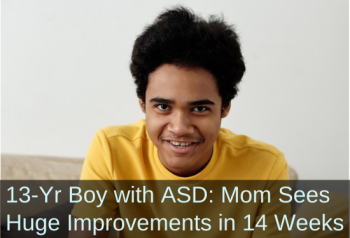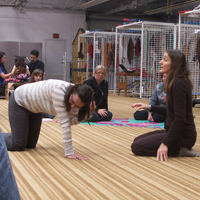Young Teen with ASD and SPD: More Regulation, More Speech, More Stamina, More Fun
Submitted by LT, parent

|
Before
|
After
|
|
Stuck in homolateral movement
|
Naturally starts opposite arms and opposite legs correctly
|
|
Poor stamina - tired very easily and needed to sit down frequently
|
Stamina improved - can walk for an hour+ with no problems
|
|
Poor posture
|
Holding himself more upright with better posture
|
|
Struggled with pincer pen grip
|
Pincer grip improved, and writing has become smaller and neater
|
|
Non-speaking
|
Speech is coming along; making better approximations of sound
|
|
Easily tipped into Fight/Flight mode, flying into aggressive outbursts
|
Now better able to self-regulate
|
ST is my son. He has a diagnosis of Autism and Sensory Processing Disorder and is non-verbal but can communicate using Makaton signing. He was born by emergency C-Section as he had the umbilical cord wrapped around his neck and shoulders and was in distress during this time so sustained significant birth trauma. We know he later also sustained some vaccine injury so there are a lot of issues going on. The result is that ST is an extremely sensitive child who is often easily tipped into Fight/Flight mode, so I knew it would be necessary to go slow with him and work on all the reflexes.
I started by introducing Rhythmic Movement [from the Brain and Sensory Foundations course] in the evening, initially both passive stimulations from the hip in fetal position which he found extremely soothing and I was able to do before bed.
The passive rolling of bottom in prone position was fairly easy for him to do, I kept my hand gently on his upper back to stabilize. Next, I added the Passive Stimulation from the Knees in Supine and over several days we gradually added in the slight head nod, chin to chest. I could see he found this difficult at first but after a few sessions he got it but needed a visual cue from me and reminder to bring his chin low to chest. I sang his favourite song to keep the rhythm and encouraged him to hum along. ST was enjoying this move however it did seem to make him go a little hyper after, so I started to do earlier in the evening.
We stayed doing Rhythmic Movements daily and introduced the Brain Tune-up [from the Brain and Sensory Foundations course] whenever his mood needed regulating and during transition times like when he got off the school bus. He was very homolateral at first, I had to hold his hands and guide opposite arm opposite leg but within a few sessions he got it and naturally started to do it correctly himself. He really enjoys the Brain Tune-up which we do whenever he needs calming down, he knows it works and so is happy to do the movements!
I know ST has retained reflexes in all areas with poor core and hand strength. I knew Moro was an issue and he suffers from fight/flight response so this would be linked to FPR.
ATNR and Head Righting had severe primitive reflex activity.
The first Primitive Reflexes I introduced were Plantar/Babinski [from the Brain and Sensory Foundations course], we did these Isometrics whilst watching TV or sitting in the garden and also the marble game picking them up with our toes and dropping them into a pot. ST also enjoyed downward dogs pushing our feet firmly into the ground, this was fun to do in the garden with shoes off on the grass.
For TLR he managed the Isometric pretty well in forward flexion but struggled a bit in the backward extension position so instead we did tummy time games [from the Brain and Sensory Foundations course].
On week three, I introduced Palmar/Babkin, still doing the previous rhythmic movements and Brain Tune-up daily but starting to alternate the reflex integrations. ST has very little hand strength so we did the finger squeezes in and out together, I did it on him and he did it on me.
ST does often have a tight jaw especially when anxious or irritated and I think this Babkin link with TMJ could really help release this stressed area. By week four, I felt he was ready to start on one of the more challenging reflexes for him the Head Righting Reflex. In assessment all side were of equal severity, he coped pretty well with the Isometric but we increased the tummy time games and did some slow rotations on a swivel chair with eyes open and eyes closed which he was apprehensive of at first but began to want more of it. ST spent lots of time on the trampoline and trying to balance on one foot too. This improved pretty quickly and we are working on doing it for a few more seconds each time. Week 5, alternating everything so far and introducing ATNR [from the Brain and Sensory Foundations course] another challenging reflex for him.
Week six, I continued alternating everything we had done so far to really embed these reflexes before adding any others. Sometimes just a minute here and there but it did allow for more to be done at a relaxed pace. Week seven added in Spinal Galant, [from the Brain and Sensory Foundations course].
Week eight, we were ready to add another challenging one, the Moro. I really feel this is a big one for ST, he has a low sensitivity to pain and it was interesting to hear this in your videos about the link to hypo-sensitivity when your body becomes so stressed it shuts down so you feel less pain. We used a large peanut ball to do "monkey hugs" and enjoy doing the three thumps and I facilitated with the passive integration of the Moro Reflex [from the Brain and Sensory Foundations course]. He also likes Hook Ups and the soothing effect of hands over the kidneys and adrenals.
Weeks nine and ten, we continued everything so far alternating the reflexes, sometimes with Isometrics sometimes through play. By week eleven I felt we were ready to introduce Fear Paralysis Reflex [from the Brain and Sensory Foundations course].
Weeks twelve and thirteen, we continued alternating and finally at week fourteen I added the final reflex STNR. We enjoyed doing the puppy stretches before bedtime and the other games we were already doing.
He is no longer stuck in homolateral and naturally starts opposite arms opposite legs correctly. I have noticed he has far more stamina when he goes out for a walk. Before he would tire very easily and need to sit down frequently, now he can walk for an hour+ with no problems.
He is also holding himself more upright with better posture. His pincer pen grip is really good now and his writing has become smaller and neater. He can now draw a figure 8 infinity sign on paper which he just could not do before and is crossing the midline with more ease. Speech is coming along too making better approximations of sound.
Although there have also been some behavioural issues and frustration as we work through the movements on the whole this passed within the first few months. He is now able to regulate himself better and not fly into aggressive outbursts so easily, he tries to contain it and the Hook Ups and Three Thump [from the Brain and Sensory Foundations course] have been a revelation. I have just completed another assessment and you can see the improvements that have been made so far. We will keep going and I hope to take the next level course to continue his development.
(Edited, emphasis added)


